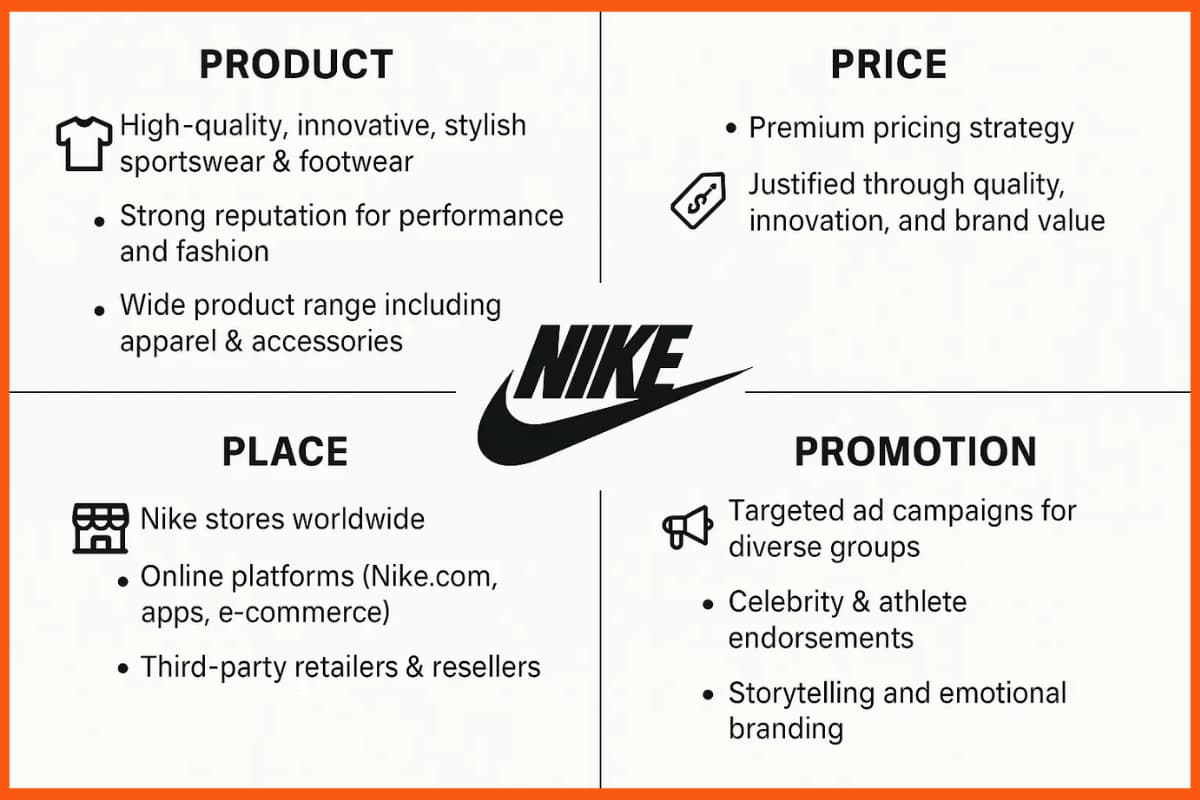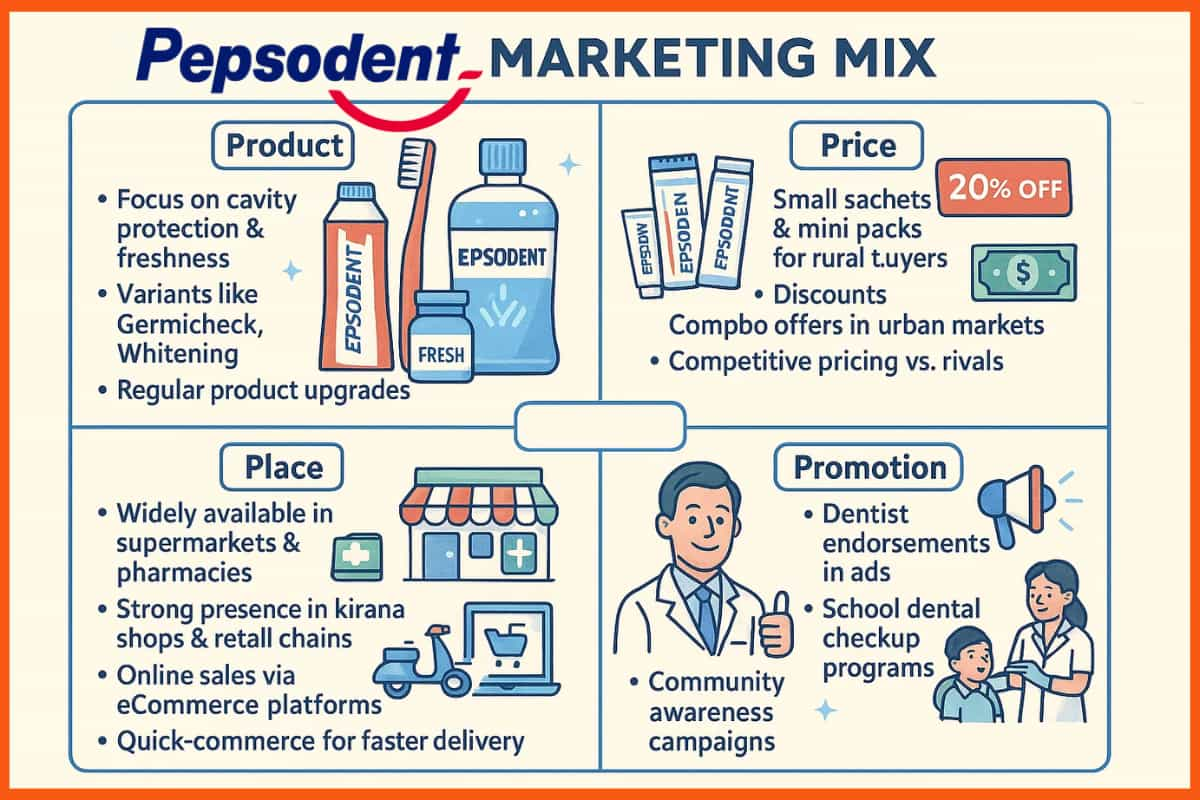Nike, Inc. is an American multinational business that designs, develops, manufactures, markets, and sells footwear, apparel, equipment, accessories, and services on a global scale.
Nike is a major player in the athletic world. The company pulled in revenue of over US$51.6 billion in its 2023 fiscal year and employs 83,700 people across the world. Just the Nike brand itself is valued at $30 billion as of 2024 – making it the most valuable brand in the sports industry. In 2018, Nike Corporation ranked 89th on the Fortune 500 list of the largest US corporations by total revenue. Nike has a 38.23 percent market share. The Nike marketing plan focuses on innovation, strong brand positioning, digital campaigns, and athlete endorsements to connect with its global audience.

Nike Target Market
Nike Marketing Mix
Nike Marketing Strategy
What Makes Nike’s Marketing and Campaigns Different?
Nike Target Market
Nike’s target audience ranges in age from 15 to 40 years old. The brand primarily targets teens who look up to famous and successful athletes. However, Nike also targets the middle-aged group to extend its popularity to the younger generation. For example, 40-year-old parents who are into football can influence their children to maintain an active lifestyle.
Nike understands that people who are constantly on the move and leading an active lifestyle are more likely to be interested in their products. This is why they focus on this psychographic segment when advertising and marketing their latest releases.

Nike specifically reminds users that its products are not about making you look good as an athlete, but about making you feel good. This is how it segments behavioral aspects.
Nike’s marketing plan focuses heavily on geographical location because sports vary so much from one place to another. For example, Nike wouldn’t be able to market to football players in India, Finland, or the Philippines because this sport isn’t nearly as popular there as it is in Mexico, England, or Australia.
Nike Marketing Mix
Nike’s marketing team is very strategic in their planning and execution – they understand how to make the most of the four Ps of marketing (product, price, promotion, place). By using a good mix of these elements, Nike can attract more potential customers, which leads to more sales for the company.

Nike Pricing Strategy
Nike’s products tend to come with a higher price tag, but this doesn’t bother customers because Nike knows how to emphasize the benefits of their products in their marketing and advertising. This is essential to consumers because it helps them understand what they’re paying for.
Nike Place Strategy
The brand also sells its products through third-party resellers and retailers, which has helped to increase sales. However, the brand has diversified its selling channels by also selling through online stores and physical locations.
Nike Product Strategy
Nike has a long-standing reputation for delivering high-quality, fashion-forward products – something that other brands can’t always say. And Nike takes pride in maintaining this hard-earned reputation.

Nike Promotion Strategy
Nike’s marketing efforts are no accident – each campaign is carefully created to target a specific group of people, even those with different demographics and psychographics.

Nike Marketing Strategy
Nike is a household name in the sports world, and its success is due in large part to its marketing strategy. By targeting people’s aspirations, comfort levels, and ethnic values, Nike has positioned itself as a positive and aspirational brand. This has helped it achieve tremendous success worldwide.
With a swoosh logo and “Just do it” tagline it has touched millions of people.
A genius collection of marketing strategies is what makes Nike a successful brand.
Nike’s success didn’t happen by accident – they worked hard to create a loyal customer base by implementing specific strategies. Let’s take a look at how they did it.
Personalization
Customers choose high-quality goods with significant advantages. Things that help them individually are simple justifications in their eyes.
Personalization is NIKE’s key competitive advantage. It positions itself as a premium fitness brand by fusing cutting-edge technology with human psychology to increase client acquisition.
Almost every component of its marketing mix uses its two-ingredient customization approach.
People may change the color of their shoes using the “Nike By You” product collection. With the addition of the most recent technology in 2018, customers could now use their smartphones to point at their feet and receive the ideal shoe size. Customers can enjoy remarkable shopping experiences at its concept stores, which elevate the retail environment.
If you provide your clients with a customized shopping experience, 77% of them will pay a premium and promote you to others.

Value Propositions
A factor driving 40% of consumers to choose NIKE items over rivals is the company’s distinctive value offer. It markets its products using a healthy lifestyle as a differentiator.
It exhorts individuals to pursue an active lifestyle and promotes its shoes as the ideal solution.
Nike swiftly followed up their Running Free campaign with a Running Free collection to inspire people to act. The marketing strategy generated a lot of interest and raised brand awareness for the product.
If you go back to NIKE’s earlier campaigns, you can see that Nike has been utilizing this strategy for decades.
To increase sales, it promoted jogging as a trend, developed a fitness routine to market its gear, and elevated its shoes to the status of a fashion statement.
Steps, Nike
To draw clients, it essentially promotes lifestyle improvements as its special selling point.
Don’t sell products, sell ideas!
Brand Equity
Because of its strong brand equity, Nike is one of the few businesses that has successfully maintained its top position for years. By developing a strong brand, distinguishable personality, and reliable image, it has solidified a position in the sports market.
Nike has sought to be connected to inspiration, success, and innovation ever since its founding in 1964. It began with a distinctive brand identity to achieve it, selecting the name of the Greek Goddess who stands for victory and the swoosh logo to symbolize speed.
It worked with well-known sportsmen to increase the value of its products, and it ran motivational ads to reinforce its brand. Its iconic logo is a status symbol for millions of customers.
Your product’s perceived worth is raised by your brand equity. It enables you to elevate your brand’s reputation and command higher pricing for your goods.
Storytelling
The cornerstone of Nike’s marketing strategy is narrative and emotionally engaging advertising. It’s how it originally attracted attention, built its reputation, and today conveys its brand values.
When it first introduced the “Just Do It” campaign in 1988, it used a straightforward setting to tell the life story of 80-year-old marathon runner Walt Scott. It still employs the Ad, which was one of its most effective marketing initiatives, to draw in consumers.
Nike – Just Do It (1988) – Very first commercial | Marketing Strategies of Nike
Its uplifting theme helped its “What are girls made of” campaign, which promoted women’s sports, garnering three million views. The “find greatness” campaigns it ran helped it grow its membership by 55% and improve revenues to $506 million.
The two instances mentioned above are just a few. NIKE uses social and occasionally contentious issues to spark interest and touch a nerve to elicit a response.
Relevance is important in advertising, and Nike incorporates this component into their marketing initiatives. The message will remain with the viewers if they can relate to the main idea and moral lesson of the advertisements.
It is one of its most successful strategies and has markedly increased its brand image. It is now considered its go-to marketing tactic.
Seamless Online Shopping Experience
Nike’s website offers a smooth and engaging online shopping experience with a bold, vibrant, and youthful theme that matches its brand image. The site uses fearless and athletic visuals, like women exercising in Nike sportswear, to connect with its audience. Customers can easily find what they want through detailed filters such as type, gender, price, color, sport, or even athlete collaborations. The site also suggests related products to make shopping quick and effortless. Plus, Nike membership gives exclusive access to special products, customization options, and personalized offers, making the overall experience more rewarding.
Endorsements
NIKE typically uses sponsorships and endorsements to sell its athletic apparel. To promote itself, it spends billions on sponsorship deals with well-known athletes and sports organizations.
Celebrities and influencers play a key role in Nike’s marketing plan. By collaborating with those who have traveled the same path as the brand, brand communication will be strengthened. The brand sponsors individual athletes. This is because people admire those who have overcome hardships in their own life.
Tiger Woods, a golfing superstar, and the company inked an agreement in 1996 that saw a $22 million rise in the value of the brand from just one game. Because of its agreement with Tiger Woods, it has attracted 4.5 million subscribers and generated considerable earnings on its own.
Another excellent example of its successful endorsement strategy, which has earned it an average of $4 billion annually to date, is its well-known association with Michael Jordan.

Endorsements also aid Nike in boosting the value of its brand. Due to its association with NFL star Colin Kaepernick, its “True to 7” shoe goods were completely sold out within hours of being on sale.
Large-scale sponsorships of events or recreational activities provide media exposure and face-to-face interaction that online marketing cannot replicate.
Product Innovation
The success of NIKE’s product strategy is frequently attributed to its emphasis on providing a better solution and enhancing performance.
The company considers the preferences of its customers and adjusts its features to fit the prevailing trends. As a consequence, its customers almost always have positive feedback to share about its products.
Bill Bowerman, the company’s creator, was a field coach who intended to create soles that might increase running speed. His research led to the “Moon Shoe,” which established the demand for lightweight shoes.
To stay ahead of the competition, NIKE also incorporates variety into its product range. It provides both casual streetwear and sportswear. Its market size has grown thanks to this strategy, which has also drawn in new market categories.
By developing innovative designs every year, NIKE increases the value of its products. Because of this, its goods are of great quality and are revolutionary.

E-retailing
As a well-known worldwide retailer, NIKE relies heavily on wholesale sales. However, if you look closely, you will see that it has heavily invested in its direct-to-consumer selling platforms. Because they not only provide a better profit margin in comparison but also make it possible to develop connections with customers.
For many years, NIKE has consistently sold its goods through respectable retailers like Urban Outfitters and Macy’s. However, when online shopping became more popular, it discovered the possibilities of direct-to-consumer marketing and changed its emphasis to eCommerce sales. Its D2C sales have increased from 15% to 38% since then.
In 2017, it formally revamped its whole distribution strategy and began severing relationships with several significant partners in favor of its physical stores and online shops.
Through its shopping online app and eCommerce businesses, it acquired millions of consumers as a result of the decision.
Nike guarantees a simple, fun, and hassle-free online shopping experience. The eCommerce platform for Nike has some incredible features:
- Bold branding on websites
- Smart product suggestions
- Detail-oriented product filtering
- Loyalty Programs
Currently, Nike anticipates that 50% of its sales will come from digital channels.
Social Media Marketing
The most popular brand globally, Nike, has by far the most social media following. Most of its postings receive frequent good feedback from its followers, and half of its tweets are shared several times.
Take a peek at Nike’s social media pages to discover how popular the company has grown. 10.1 million people follow it on X (formerly Twitter) and 305 million people follow it on Instagram (as of July 2024). Nike often asks its followers to share their own stories and experiences using hashtags. This is part of their digital marketing strategy to start conversations and build a sense of community.

Over 300 accounts are maintained across all social media platforms. Many major corporations do have control over many sites, but Nike goes a step further by creating different pages for its goods, consumer demographics, and geolocation. This makes it possible for it to quickly develop targeted ads and drive relevant traffic to its product websites.
With interactive challenges, it keeps its fans thoroughly delighted. By establishing programs like The Chance and Fuel Your Team, NIKE engages its fans directly, garners a ton of attention, and expands its reach.
Nike’s social media marketing strategy uses the following tactics:
- Collaborate with eminent personalities
- Participate in consumer dialogues
- Using user-generated content
- Spread out your stories throughout social media platforms
The majority of NIKE’s social media tactics aren’t all that distinctive from those of other powerful businesses. It has only been able to establish a more substantial online presence as a result of utilizing social media interaction tools.
Therefore, if you want to use Nike’s marketing tactics, you must identify your target demographic, determine how to reach them, and provide content that speaks to their needs. Also, keep in mind: Sell ideas, not products!

FAQs
What is Nike most popular for?
Nike is best known for its footwear, apparel, and equipment.
What are the marketing strategies that helped Nike build a loyal customer base?
Here is a list of marketing strategies that helped Nike build a loyal customer base and build a globally popular brand:
- Personalization
- Value proposition
- Brand Equity
- Storytelling
- Endorsements
- Product innovation
- E-retailing
- Social media strategy
What is Nike’s targeting strategy?
Nike’s target audience ranges in age from 15 to 40 years old. The brand primarily targets teens who look up to famous and successful athletes. However, Nike also targets the middle-aged group to extend its popularity to the younger generation.
What is Nike product development strategy?
Nike’s product development strategy focuses on innovation, technology, and style, creating high-performance sportswear that blends function with fashion while collaborating with athletes and designers to stay ahead of trends.
What is Nike advertising strategy?
Nike’s advertising strategy uses emotional storytelling, athlete endorsements, and bold campaigns to inspire and connect with audiences worldwide.







































